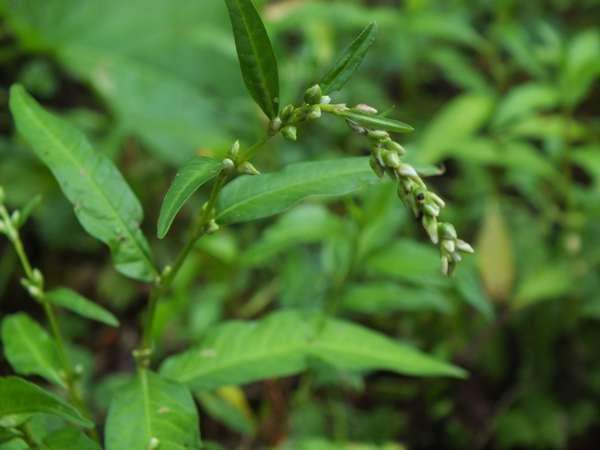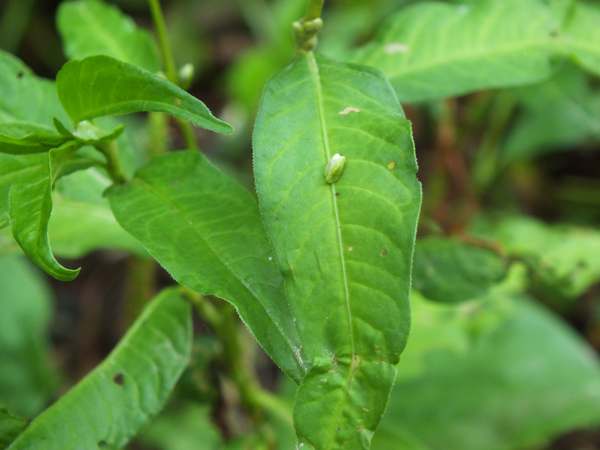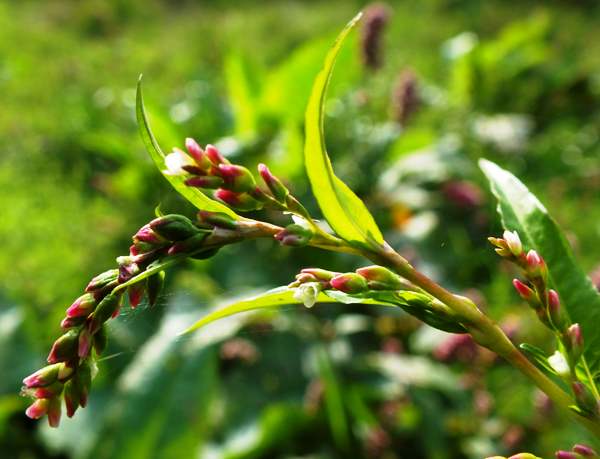Trees Birds Mammals Fish Amphibians Reptiles
Wild Algarve
Bookshop
Persicaria hydropiper - Water-pepper
Phylum: Magnoliophyta - Class: Equisetopsida - Order: Caryophyllales - Family: Polygonaceae

This unimposing weed of wet places is one of the early colonisers of ground following major disturbance, but it easily overlooked because its pallid flowers are sovery small.
Description
The upright branching stems of Water-pepper are hairless and have alternate blunt-tipped lanceolate leaves whose margins are fringed with fine hairs. This annual weed grows to between 20 and 75cm.

Drooping spikes of tiny flowers, pink when in bud but greenish white when open, branch from sheathed nodes; the terminal flower spike is usually longer than the others.
The flowers are typically just 4mm long with a corolla comprising four or sometimes five petal-like segments joined near their greenish bases. Each hermaphrodite flower has six stamens, three fused carpels and three styles; the flowers are self fertilising, and reproduction is via seeds..
Distribution
Water-pepper is common and widespread throughout Britain and Ireland except for the far north of Scotland.
This plant has a very wide global distribution that includes most of mainland Europe, North Africa, temperate parts of Asia, Australia, New Zealand and North America.

Habitat
You will find plenty of Water-pepper in ditches and other marshy areas and in the margins of small streams and ponds, although it is also quite commonly seen in dry areas where the ground has been disturbed - farm gateways, refuse tips and even building sites, for example.
Blooming Times
In Britain and Ireland Water-pepper blooms from June through to the end of September.
Uses
Leaves of Water-pepper have a strong peppery taste and have been used in oriental spice mixtures and, in small quantities, in salads.
Medicinal properties have been claimed for extracts from Persicaria hydropiper, and its acidic juices can be used to dye wool yellow.
Etymology
Persicaria, the generic name, relates the shape of leaves of this group of plants to those of a peach tree. The specific epithet hydropiper translates to water pepper.
This flower gets its common name Water-pepper (sometimes written as Water Pepper) from its preference for wet habitats and the peppery taste of the leaves.
Similar Species
Amphibious Bistort Persicaria amphibia produces upright flower spikes and often grows with its roots permanently under water.
Redshank Persicaria maculosa often grow with Water-pepper; there are usually distinctive dark blotches on its leaves and is stems generally have a red flush, especially above nodes or knots.
Sue Parker's latest ebook is a revised and enlarged edition of Wild Orchids in The Burren. Full details here...
Buy it for just £5.95 on Amazon...
Sue Parker's new ebook is a comprehensive and fully revised edition of her acclaimed field guide to the Wild Orchids of Wales. Full details here...
Buy it for just £5.95 on Amazon...
Please Help Us: If you have found this information interesting and useful, please consider helping to keep First Nature online by making a small donation towards the web hosting and internet costs.
Any donations over and above the essential running costs will help support the conservation work of Plantlife, the Rivers Trust and charitable botanic gardens - as do author royalties and publisher proceeds from books by Pat and Sue.